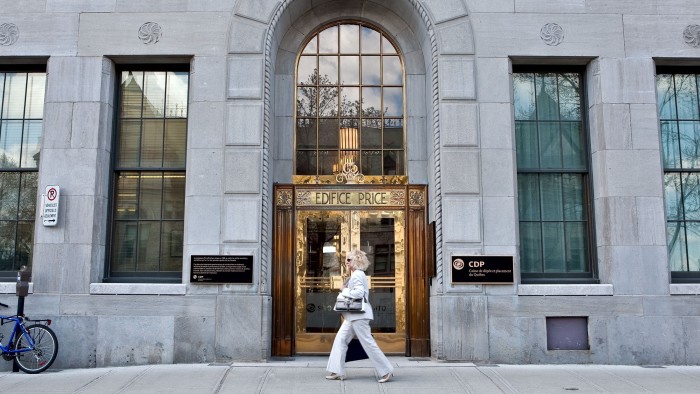Stay informed with free updates
Simply sign up to the Pensions industry myFT Digest — delivered directly to your inbox.
Top pension funds are stepping back from competing head-on with private equity groups to buy up companies, instead opting to invest alongside them to secure access to the best deals.
Caisse de dépôt et placement du Québec (CDPQ) and the Ontario Municipal Employees Retirement System (Omers) are scaling back the proportion of their funds exposed to directly owned private companies, while Ontario Teachers’ Pension Plan has said it is eyeing more strategic partnerships.
A tough period for exiting investments over the past two years has encouraged the Canadian pension groups to back more companies alongside huge private equity managers as direct ownership has become increasingly challenging, requiring big in-house teams and a higher risk appetite.
“The private equity downturn is making the direct investing model harder as we are facing a shortage of viable projects and difficulty in exiting from our existing investments,” said an executive at one of the funds.
There are three main ways pension funds allocate to private equity: direct investing, where they buy a stake in a company on their own; through a private equity fund; or through co-investments, where they invest in companies alongside a private equity fund but without having to pay the fund fees.
Canada’s $3.2tn pension system is a major private equity investor with 22 per cent of its public sector funds’ assets allocated to the asset class, according to think-tank New Financial.
At present, the nine biggest Canadian pension funds have about half of their private equity exposure in buyout funds and half through direct holdings and co-investments, according to analysis from CEM Benchmarking.
But that balance has shifted as pension funds have come under pressure to invest in buyout funds to secure access to the best co-invest deals, where they get to invest alongside the firms but without having to pay fund fees.
CDPQ is in the second year of a five-year plan to lower the proportion of direct private equity investments from 75 per cent to 65 per cent, while Omers pivoted from allocating very little to private equity funds to announcing last September it would no longer invest directly in European opportunities.
Ontario Teachers’ has said it is “tactically looking to invest more with other partners in areas where it makes sense as the portfolio and market evolves”, though direct investments are still a core part of its strategy.
The shift comes as the private equity industry has ballooned in size, resulting in fierce competition for both assets and talent — and as some Canadian pension funds are also rethinking their US exposure.
Marlene Puffer, former chief investment officer at Alberta Investment Management Corporation, said Canadian pension funds were “in the boat of having to add more value into every holding because exits are more challenging now — they have to do more hands on management and it becomes increasingly complex”.
She added that pension plans allocated money to private equity funds on the understanding that they would be invited to invest in many of the co-investment opportunities that arise with them.
It was “difficult for Canadian pension funds to compete for talent with Apollo that pays much better”, another fund executive said.
Martin Longchamps, CDPQ’s head of private equity and credit, said the rationale behind its shift towards more partnerships was to “drive access to deal flow through those relationships”. Omers’ chief investment officer, Ralph Berg, said the pension fund had “evolved our investment strategy over the last couple of years to explore different models and use funds where it is complementary”.
Canada Pension Plan Investment Board, the country’s largest pension fund with C$699bn (US$504bn) in assets, said it had “always pursued a partnership strategy and continue to be committed to that approach”.
Additional reporting by Ivan Levingston in London
https://www.ft.com/content/6e15e1ab-da21-4c29-8dbc-010dc0b56e8a


